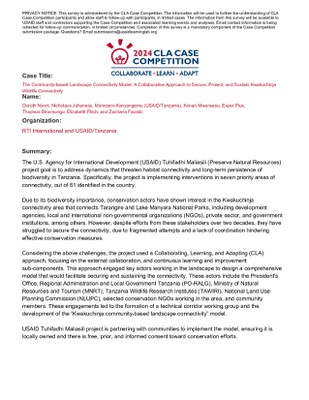The Community-Based Landscape Connectivity Model: A Collaborative Approach to Secure, Protect and Sustain Kwakuchinja Wildlife Connectivity

Author(s): Nicholaus Johaness , Munezero Kanyangemu , Kenan Mwansasu , Exper Pius , Thadeus Binamungu , Elizabeth Flitch , Zarcharia Faustin , Doroth Nyoni
Publication Date: 2024
DOWNLOAD FILEThis 2024 USAID Collaborating, Learning, and Adapting (CLA) Case Competition winner is about the USAID Tuhifadhi Maliasili (Preserve Natural Resources) project.
The USAID Tuhifadhi Maliasili (Preserve Natural Resources) project goal is to address dynamics that threaten habitat connectivity and long-term persistence of biodiversity in Tanzania. Specifically, the project is implementing interventions in seven priority areas of connectivity out of 61 identified in the country.
Due to its biodiversity importance, conservation actors have shown interest in the Kwakuchinja connectivity area that connects Tarangire and Lake Manyara National Parks, including development agencies, local and international Non-Governmental Organizations (NGOs), private sector, and government institutions, among others. However, despite efforts from these stakeholders over two decades, they have struggled to secure the connectivity due to fragmented attempts and a lack of coordination hindering effective conservation measures.
Considering the above challenges, the project used a Collaborating, Learning, and Adapting (CLA) approach, focusing on the external collaboration, and continuous learning and improvement sub-components. This approach engaged key actors working in the landscape to design a comprehensive model that would facilitate securing and sustaining the connectivity. These actors include the President's Office, Regional Administration and Local Government Tanzania (PO-RALG), Ministry of Natural Resources and Tourism (MNRT), Tanzania Wildlife Research Institutes (TAWIRI), National Land Use Planning Commission (NLUPC), selected conservation NGOs working in the area, and community members. These engagements led to the formation of a technical corridor working group and the development of the “Kwakuchinja community-based landscape connectivity” model. USAID Tuhifadhi Maliasili project is partnering with communities to implement the model, ensuring it is locally owned and there is free, prior, and informed consent towards conservation efforts.
This USAID 2024 CLA Case Competition winner was originally published on Learning Lab.



